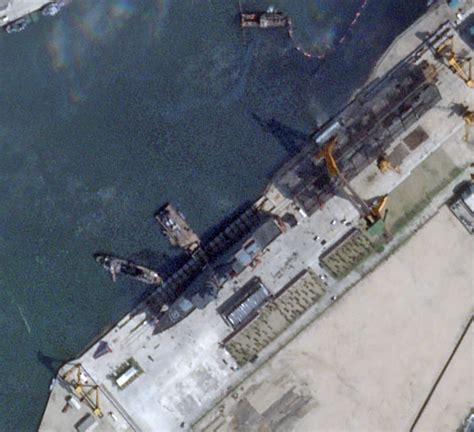
A partially submerged North Korean frigate has reappeared in recent satellite imagery near the Mayang-do naval base, rekindling speculation about its fate and operational status. The vessel, which was first observed partially sunk in November 2023, was seen afloat again in images taken in early June, according to reports from Radio Free Asia (RFA), raising questions about whether it was salvaged, refloated, or if the imagery indicates deceptive practices.
The reappearance of the frigate has spurred renewed analysis by experts, focusing on the implications for North Korea’s naval capabilities and the potential strategic messaging behind the vessel’s ambiguous status. The incident occurs amid heightened tensions in the region and ongoing scrutiny of North Korea’s military activities, particularly its naval developments. The frigate’s on-again, off-again visibility has become a focal point for observers attempting to decipher North Korea’s intentions.
The vessel, a relatively small warship by international standards, represents a component of North Korea’s aging but substantial naval fleet. Its value is more symbolic and strategic, given the limitations of its technology compared to modern naval powers. The ambiguity surrounding its condition serves North Korea’s broader strategic communication efforts.
Satellite images analyzed by RFA showed the frigate in a visibly different state compared to images from late last year. In November, the vessel was clearly submerged, with only a portion of its hull visible above water. The recent images, however, indicate that the ship is now afloat, albeit with some questions remaining about its overall seaworthiness.
The timing of the frigate’s reappearance coincides with heightened military activities in the region. North Korea has been actively testing various missile systems and engaging in military exercises, signaling its resolve to enhance its defense capabilities. The ambiguity surrounding the frigate could be interpreted as part of a broader effort to maintain strategic ambiguity and keep adversaries guessing about North Korea’s true military readiness.
According to military analysts, deciphering North Korea’s intentions requires a comprehensive assessment of satellite imagery, intelligence reports, and geopolitical context. The frigate incident is just one piece of a larger puzzle, demanding careful scrutiny to understand the full scope of North Korea’s strategic calculations.
The specific class and capabilities of the frigate remain subjects of analysis, with experts noting its likely role in coastal defense and limited offshore operations. The ship’s age and technology suggest it is not a frontline asset, but its symbolic value cannot be understated.
The reasons behind the initial sinking remain unclear. Theories range from accidental damage to intentional submersion for maintenance purposes or as part of a deception strategy. North Korea has not officially commented on the matter, adding to the mystery.
The ambiguity surrounding the frigate underscores the challenges in assessing North Korea’s military capabilities and strategic intentions. The reappearance of the vessel serves as a reminder of the need for continued vigilance and in-depth analysis to understand the evolving security landscape in the Korean Peninsula.
Detailed Analysis of the Situation
The reappearance of the North Korean frigate is more than just a fleeting curiosity; it offers a complex case study in military intelligence, strategic communication, and geopolitical maneuvering. To fully understand the situation, a detailed exploration of the context, technology, and potential motivations is essential.
Context: The Broader Security Landscape
North Korea’s military activities are inextricably linked to the broader security landscape in Northeast Asia. The Korean Peninsula remains one of the world’s most militarized zones, with a history of conflict and persistent tensions. The armistice agreement that ended the Korean War in 1953 remains in place, but a formal peace treaty has never been signed. This unresolved status contributes to ongoing instability and mutual distrust.
North Korea’s nuclear and missile programs have been a central point of contention for decades. Despite international sanctions and diplomatic efforts, Pyongyang has continued to develop and test advanced weapons systems. These actions are viewed by many countries, including the United States, South Korea, and Japan, as direct threats to regional security.
The United States maintains a significant military presence in South Korea, with tens of thousands of troops stationed there as part of a mutual defense treaty. These forces serve as a deterrent against North Korean aggression and provide crucial support to South Korea’s defense capabilities. The presence of US forces also complicates the strategic calculus for North Korea, influencing its decisions regarding military posture and provocation.
China, North Korea’s closest ally and primary trading partner, plays a critical role in the region. While China has officially supported international sanctions against North Korea’s nuclear program, its level of enforcement and overall influence remain subjects of debate. China’s strategic interests in the region, including maintaining stability and preventing the collapse of the North Korean regime, shape its approach to the situation.
Technology and Capabilities: Assessing the Frigate’s Role
The North Korean frigate in question is a relatively small and outdated warship compared to modern naval vessels. Its primary role would likely be coastal defense, patrolling territorial waters, and supporting limited offshore operations. The ship’s technology is likely to be several decades old, lacking the advanced sensors, weapons systems, and stealth capabilities of contemporary warships.
Despite its limitations, the frigate is part of a larger naval fleet that North Korea maintains. The fleet includes a mix of surface combatants, submarines, and patrol boats, many of which are also aging and technologically inferior to those of its adversaries. However, the sheer size of the North Korean navy presents a challenge for regional security.
North Korea’s naval strategy is focused on asymmetric warfare, emphasizing the use of submarines, mines, and anti-ship missiles to counter the superior naval power of its adversaries. These tactics are designed to exploit vulnerabilities and inflict damage in the event of a conflict. The frigate, while not a central component of this strategy, could still play a role in coastal defense and support operations.
The reappearance of the frigate raises questions about its seaworthiness and operational status. If the ship was indeed salvaged or refloated, it would likely require significant repairs and maintenance to restore it to full operational capability. The extent of the damage it sustained during its submersion would be a key factor in determining its future usefulness.
Strategic Messaging: Decoding North Korea’s Intentions
North Korea has a long history of using strategic ambiguity and calculated provocations to achieve its political and military objectives. The ambiguous status of the frigate could be part of this broader strategy, designed to keep adversaries guessing about North Korea’s true intentions and capabilities.
By allowing the frigate to be observed in a partially submerged state and then reappearing afloat, North Korea may be attempting to send several messages:
- Resilience: The reappearance of the frigate could be intended to demonstrate North Korea’s resilience and determination to overcome challenges, even in the face of adversity. This message is aimed at both domestic and international audiences, projecting an image of strength and resolve.
- Deception: The frigate incident could be part of a broader deception strategy, designed to mislead adversaries about North Korea’s true naval capabilities. By presenting a confusing picture of the ship’s status, North Korea may be attempting to complicate intelligence gathering and analysis.
- Provocation: The ambiguity surrounding the frigate could be a calculated provocation, intended to test the reactions of the United States, South Korea, and other regional actors. By pushing boundaries and observing the responses, North Korea can gain valuable insights into its adversaries’ intentions and red lines.
- Distraction: The frigate incident could serve as a distraction from other, more significant military activities that North Korea is undertaking. By focusing attention on the ambiguous status of the ship, North Korea may be attempting to divert scrutiny from other weapons development programs or military exercises.
The Role of Satellite Imagery in Intelligence Gathering
Satellite imagery has become an indispensable tool for intelligence gathering and analysis, providing valuable insights into North Korea’s military activities. High-resolution satellite images can reveal details about military installations, weapons systems, and troop movements that would be difficult or impossible to obtain through other means.
The reappearance of the North Korean frigate was detected through satellite imagery, highlighting the importance of this technology for monitoring North Korea’s military activities. Analysts can use satellite images to track changes in the ship’s status over time, assess the extent of any damage, and estimate its operational capabilities.
However, satellite imagery analysis is not without its challenges. Interpreting satellite images requires specialized expertise and a thorough understanding of military technology and tactics. It is also important to consider factors such as weather conditions, image resolution, and the angle of observation, which can affect the accuracy of the analysis.
Furthermore, North Korea is aware of the use of satellite imagery and may take steps to conceal its military activities or create false impressions. This could include camouflaging equipment, conducting operations at night, or employing deception techniques to mislead observers.
Expert Opinions and Assessments
Military analysts and experts have offered a range of opinions and assessments regarding the North Korean frigate incident. Some have suggested that the reappearance of the ship is a sign of North Korea’s resilience and determination, while others have cautioned against drawing definitive conclusions without more information.
One common theme in expert commentary is the importance of considering the frigate incident in the context of North Korea’s broader strategic goals and military activities. Experts emphasize the need to analyze satellite imagery in conjunction with other sources of intelligence, such as human intelligence and signals intelligence, to gain a comprehensive understanding of the situation.
Some analysts have also suggested that the frigate incident could be a test of the international community’s resolve to enforce sanctions against North Korea. By engaging in ambiguous and provocative behavior, North Korea may be attempting to probe the limits of international tolerance and assess the willingness of other countries to take action.
The Implications for Regional Security
The reappearance of the North Korean frigate has implications for regional security, particularly in the context of ongoing tensions and military activities in the Korean Peninsula. The incident serves as a reminder of the unpredictable nature of North Korea’s behavior and the need for continued vigilance and deterrence.
The United States and South Korea have been conducting joint military exercises in the region, designed to enhance their readiness to respond to potential North Korean aggression. These exercises are often met with condemnation from North Korea, which views them as provocative and a threat to its security.
The ambiguity surrounding the frigate could further complicate the strategic calculations of regional actors, making it more difficult to assess North Korea’s intentions and respond effectively to potential threats. This uncertainty underscores the need for clear communication, robust intelligence gathering, and strong diplomatic efforts to manage tensions and prevent escalation.
The incident highlights the importance of maintaining a credible deterrent against North Korean aggression, while also pursuing diplomatic solutions to address the underlying causes of instability in the Korean Peninsula. A comprehensive approach that combines military strength with diplomatic engagement is essential to promoting long-term peace and security in the region.
Future Developments and Monitoring
The situation surrounding the North Korean frigate is likely to evolve in the coming weeks and months. Continued monitoring of satellite imagery and other sources of intelligence will be crucial for tracking changes in the ship’s status and assessing its operational capabilities.
It will also be important to observe North Korea’s overall military activities and strategic communications, looking for clues about its intentions and goals. Any significant developments in North Korea’s nuclear and missile programs, or changes in its military posture, could have implications for regional security and the frigate incident.
The international community will need to remain united in its efforts to deter North Korean aggression and promote denuclearization. Strong sanctions enforcement, coordinated diplomatic pressure, and clear communication of red lines are essential to preventing escalation and achieving a peaceful resolution to the Korean Peninsula crisis.
The reappearance of the North Korean frigate is a complex and multifaceted issue that requires careful analysis and a nuanced understanding of the geopolitical context. By combining in-depth intelligence gathering with strategic thinking and diplomatic engagement, the international community can work to manage the risks and promote long-term stability in the region.
Frequently Asked Questions (FAQ)
- What type of ship is the North Korean frigate and what is its purpose?
The specific class of the frigate is not explicitly stated, but it is generally described as a relatively small and outdated warship. Its primary purpose would likely be coastal defense, patrolling North Korean territorial waters, and supporting limited offshore operations. Its technology is likely several decades old, lacking the advanced capabilities of modern warships.
- Why was the frigate initially reported as partially submerged?
The exact cause of the initial submersion is unknown. Possible explanations include accidental damage, intentional submersion for maintenance, or even as part of a deception strategy. North Korea has not commented officially, fueling speculation.
- What does the reappearance of the frigate in satellite imagery suggest?
The reappearance suggests several possibilities: it may have been salvaged and refloated, or the images could be misleading, showing the ship in a different state than its actual condition. Regardless, it is interpreted as a strategic signal from North Korea.
- How reliable is satellite imagery for assessing North Korean military activities?
Satellite imagery is a valuable tool but not foolproof. It provides crucial visual intelligence, but interpretation requires expertise. North Korea may also employ camouflage or deception tactics to mislead satellite observations.
- What implications does this incident have for regional security?
The incident raises concerns about North Korea’s intentions and military capabilities. It underscores the need for continued vigilance, strong deterrence, and diplomatic efforts to manage tensions and prevent escalation in the Korean Peninsula.
- How does this frigate compare to modern naval vessels in terms of capabilities and technology?
The North Korean frigate is considered relatively small and outdated compared to modern naval vessels. It lacks the advanced sensors, weapons systems, and stealth capabilities found in contemporary warships, making its primary role focused on coastal defense rather than engaging in large-scale naval operations.
- What are some of the asymmetric warfare tactics employed by North Korea’s navy, and how does the frigate fit into those tactics?
North Korea’s naval strategy emphasizes asymmetric warfare tactics, such as the use of submarines, mines, and anti-ship missiles, to counter the superior naval power of its adversaries. While the frigate is not a central component of this strategy, it could still play a role in coastal defense and support operations, contributing to the overall defensive posture.
- What are the potential messages that North Korea may be trying to convey through the ambiguous status of the frigate?
North Korea may be attempting to send several messages, including resilience, demonstrating the ability to overcome challenges; deception, misleading adversaries about its true naval capabilities; provocation, testing the reactions of regional actors; and distraction, diverting attention from other military activities.
- How do the United States and South Korea typically respond to military activities and provocations by North Korea?
The United States and South Korea conduct joint military exercises, designed to enhance their readiness to respond to potential North Korean aggression. They also maintain a strong deterrent posture, signaling their commitment to defending South Korea and maintaining regional stability. Diplomatic efforts are also pursued to address the underlying causes of instability.
- What role does China play in the security dynamics of the Korean Peninsula, and how does its relationship with North Korea influence the situation?
China is North Korea’s closest ally and primary trading partner, playing a critical role in the region. While China has officially supported international sanctions against North Korea’s nuclear program, its level of enforcement and overall influence remain subjects of debate. China’s strategic interests in the region, including maintaining stability and preventing the collapse of the North Korean regime, shape its approach to the situation.
- What kind of repairs and maintenance would the frigate likely require if it was indeed salvaged or refloated, and how might that impact its operational capability?
If the frigate was salvaged or refloated, it would likely require significant repairs and maintenance to restore it to full operational capability. The extent of the damage it sustained during its submersion would be a key factor in determining its future usefulness. This could include repairing hull breaches, overhauling mechanical and electrical systems, and updating outdated technology.
- How has North Korea used strategic ambiguity and calculated provocations in the past to achieve its political and military objectives?
North Korea has a long history of using strategic ambiguity and calculated provocations to achieve its political and military objectives. Examples include conducting nuclear and missile tests, engaging in cyberattacks, and making bellicose statements. These actions are often designed to extract concessions from the international community, project an image of strength, and deter potential adversaries.
- What are the key challenges in interpreting satellite images of North Korean military activities, and how can these challenges be overcome?
Interpreting satellite images requires specialized expertise and a thorough understanding of military technology and tactics. Factors such as weather conditions, image resolution, and the angle of observation can affect the accuracy of the analysis. North Korea may also take steps to conceal its military activities. These challenges can be overcome by using multiple sources of intelligence, employing advanced image processing techniques, and consulting with experts on North Korean military affairs.
- How does the international community typically respond to North Korea’s violations of international sanctions and agreements related to its nuclear and missile programs?
The international community typically responds with a combination of diplomatic pressure, sanctions enforcement, and military deterrence. The United Nations Security Council has imposed numerous sanctions on North Korea, targeting its nuclear and missile programs, as well as its economy. Individual countries, such as the United States, have also imposed their own sanctions. The goal is to compel North Korea to abandon its weapons programs and comply with international norms.
- What are the potential long-term implications of North Korea’s continued development of its nuclear and missile programs for regional and global security?
North Korea’s continued development of its nuclear and missile programs poses a significant threat to regional and global security. It increases the risk of nuclear proliferation, undermines international nonproliferation efforts, and could lead to a destabilizing arms race in Northeast Asia. It also raises the possibility of miscalculation or escalation, potentially leading to a conflict with devastating consequences.
- How can the international community work together to address the underlying causes of instability in the Korean Peninsula and promote long-term peace and security in the region?
The international community can work together by pursuing a comprehensive approach that combines military strength with diplomatic engagement. This includes maintaining a credible deterrent against North Korean aggression, while also pursuing diplomatic solutions to address the underlying causes of instability. Dialogue, negotiation, and confidence-building measures are essential to reducing tensions and promoting long-term peace and security in the region.
- What types of resources and expertise are required to effectively monitor North Korea’s military activities and strategic communications?
Effectively monitoring North Korea’s military activities and strategic communications requires a combination of technical resources, analytical expertise, and intelligence gathering capabilities. This includes access to high-resolution satellite imagery, advanced signals intelligence technology, human intelligence networks, and a team of experts with knowledge of North Korean military affairs, political dynamics, and language skills.
- What are some of the challenges in predicting North Korea’s future behavior, and how can these challenges be mitigated?
Predicting North Korea’s future behavior is challenging due to the regime’s opacity, unpredictability, and history of deception. The challenges can be mitigated by using a variety of intelligence sources, employing analytical frameworks that consider multiple scenarios, and consulting with experts who have deep knowledge of North Korean affairs. It is also important to be prepared for unexpected developments and to adapt strategies accordingly.
- How does the presence of US military forces in South Korea influence North Korea’s strategic calculations and decision-making process?
The presence of US military forces in South Korea serves as a deterrent against North Korean aggression and provides crucial support to South Korea’s defense capabilities. This presence complicates the strategic calculus for North Korea, influencing its decisions regarding military posture and provocation. North Korea views the US military presence as a threat to its security and may seek to counter it through various means, including developing advanced weapons systems and engaging in asymmetric warfare tactics.
- What role does international law play in addressing the challenges posed by North Korea’s nuclear and missile programs, and how can it be strengthened?
International law plays a crucial role in addressing the challenges posed by North Korea’s nuclear and missile programs. The United Nations Security Council resolutions, which are binding under international law, impose sanctions on North Korea and prohibit its development of nuclear weapons and ballistic missiles. These laws can be strengthened by ensuring consistent enforcement, expanding their scope to address emerging threats, and promoting universal adherence to international nonproliferation norms. Diplomatic efforts to resolve the underlying causes of the conflict are also important.









